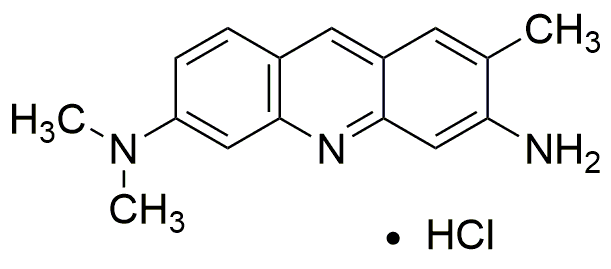Coriphosphine O is widely utilized in research focused on:
- Neuroscience Research: It serves as a potent tool for studying neurodegenerative diseases, particularly Alzheimer's, by facilitating the understanding of tau protein aggregation.
- Pharmaceutical Development: This compound is used in the formulation of drugs aimed at enhancing cognitive function, providing a potential therapeutic avenue for memory-related disorders.
- Biochemical Assays: Coriphosphine O is employed in various assays to evaluate the efficacy of compounds that target tau pathology, making it valuable for drug screening processes.
- Cell Culture Studies: It is utilized in cell culture systems to investigate cellular responses to neurotoxic agents, helping researchers understand the mechanisms of neuronal damage.
- Diagnostic Applications: The compound can be integrated into diagnostic tools for early detection of tau-related pathologies, offering significant advantages in patient management and treatment strategies.
General Information
Properties
Safety and Regulations
Applications
Coriphosphine O is widely utilized in research focused on:
- Neuroscience Research: It serves as a potent tool for studying neurodegenerative diseases, particularly Alzheimer's, by facilitating the understanding of tau protein aggregation.
- Pharmaceutical Development: This compound is used in the formulation of drugs aimed at enhancing cognitive function, providing a potential therapeutic avenue for memory-related disorders.
- Biochemical Assays: Coriphosphine O is employed in various assays to evaluate the efficacy of compounds that target tau pathology, making it valuable for drug screening processes.
- Cell Culture Studies: It is utilized in cell culture systems to investigate cellular responses to neurotoxic agents, helping researchers understand the mechanisms of neuronal damage.
- Diagnostic Applications: The compound can be integrated into diagnostic tools for early detection of tau-related pathologies, offering significant advantages in patient management and treatment strategies.
Documents
Safety Data Sheets (SDS)
The SDS provides comprehensive safety information on handling, storage, and disposal of the product.
Product Specification (PS)
The PS provides a comprehensive breakdown of the product’s properties, including chemical composition, physical state, purity, and storage requirements. It also details acceptable quality ranges and the product's intended applications.
Certificates of Analysis (COA)
Search for Certificates of Analysis (COA) by entering the products Lot Number. Lot and Batch Numbers can be found on a product’s label following the words ‘Lot’ or ‘Batch’.
*Catalog Number
*Lot Number
Certificates Of Origin (COO)
This COO confirms the country where the product was manufactured, and also details the materials and components used in it and whether it is derived from natural, synthetic, or other specific sources. This certificate may be required for customs, trade, and regulatory compliance.
*Catalog Number
*Lot Number
Safety Data Sheets (SDS)
The SDS provides comprehensive safety information on handling, storage, and disposal of the product.
DownloadProduct Specification (PS)
The PS provides a comprehensive breakdown of the product’s properties, including chemical composition, physical state, purity, and storage requirements. It also details acceptable quality ranges and the product's intended applications.
DownloadCertificates of Analysis (COA)
Search for Certificates of Analysis (COA) by entering the products Lot Number. Lot and Batch Numbers can be found on a product’s label following the words ‘Lot’ or ‘Batch’.
*Catalog Number
*Lot Number
Certificates Of Origin (COO)
This COO confirms the country where the product was manufactured, and also details the materials and components used in it and whether it is derived from natural, synthetic, or other specific sources. This certificate may be required for customs, trade, and regulatory compliance.

